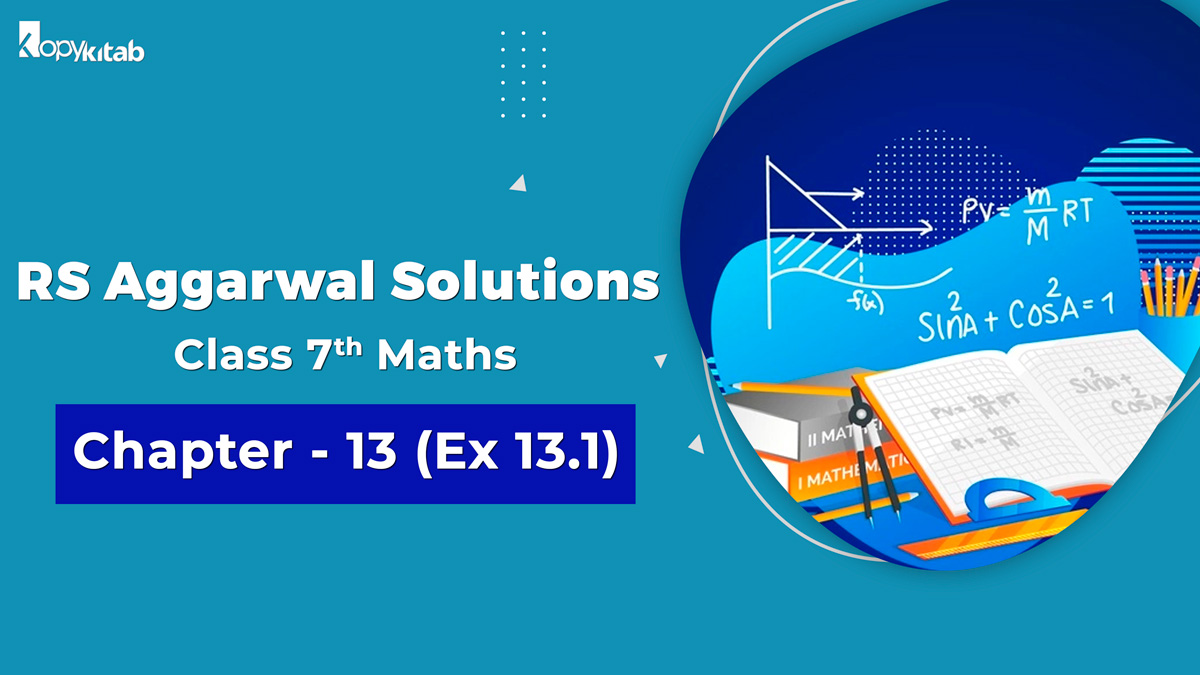
RS Aggarwal Solutions Class 7 Maths Chapter 13 Ex 13.1: You can rely totally on the RS Aggarwal Solutions Class 7 Maths, be it your class tests or assignments. It is because the solutions of RS Aggarwal Solutions Class 7 Maths Chapter 13 Ex 13.1 are very helpful in clearing your doubts. The solutions are designed by subject matter experts and are very credible.
Download the Free PDF of RS Aggarwal Solutions Class 7 Maths Chapter 13 Ex 13.1 by using the download link in the blog. To know more, read the whole blog.
Download RS Aggarwal Solutions Class 7 Maths Chapter 13 Ex 13.1 PDF
RS Aggarwal Solutions Class 7 Maths Chapter 13 Ex 13.1
RS Aggarwal Solutions Class 7 Maths Chapter 13 Ex 13.1 – Overview
Basic Concepts
Here are the basic concepts of this exercise:
- Adjacent and Vertical Angles
- Complementary Angles
- Supplementary Angles
- Alternate Angles
Important Topics
Here are the important topics you must cover
- Introduction
- Related Angles
- Complementary angles
- Supplementary angles
- Adjacent angles
- Linear pair
- Vertically opposite angles
- Pairs of Lines
- Intersecting lines
- Transversal
- Angles made by the transversal
- Transversal of Parallel Lines
- Checking for Parallel Lines
Definitions
- Line: A figure that can be extended as much as you want in the opposite directions without any obligations on having the endpoints is called a line.
- Ray: The completely straight line that is starting from a fixed point moving only in one direction is called a ray.
- Line Segment: It can be defined as the line made using the two definite starting and ending points. It doesn’t have any thickness & is only a one-dimensional figure.
- Angle: An angle is formed when the two line segments are joined at a single point. It is a combination of at least two line segments meeting at a common point, called as the vertex of the angle. The sides/arms of the formed angle are those two line segments only.
Types OF Angles
There are 6 types of angles, mentioned below:
- Acute Angle: It can be defined as angles less than 90 degrees.
- Obtuse Angle: An angle that can be defined as angles more than 90 degrees.
- Right Angle: An angle that can be defined as an angle formed exactly at 90 degrees.
- Straight Angle: An angle that can be defined as an angle formed exactly at 180 degrees.
- Reflex Angle: Angle: An angle that can be defined as an angle of mof ore 180 degrees but less than 270 degrees.
- Full Angle: An angle that can be defined as an angle formed exactly at 360 degrees.
Related Angles
Apart from the other six angles, here are some related angles you should know about.
- Complementary Angle: When the sum of two angles measures is equivalent to 90°, then we call it the Complementary Angle.
- Supplementary Angle: When the sum of two angles measures is equivalent to 180°, then we call it the Supplementary Angle.
- Adjacent Angle: These angles are the ones having a common vertex plus a common arm. Additionally, they do not possess any common interior points.
- Linear pair: It can be defined as the pair of adjacent angles, and its non-common sides are the opposite rays.
- Vertically Opposite Angles: The vertically opposite angles formed whenever the two lines intersect with each other are always equal.
Pairs Of Lines
- Intersecting lines: The Intersection between the two or more lines happens only if they are having a common point. The common point symbolized as O is what we call their point of intersection.
- Transversal: It can be defined as the Intersection between two or more lines at different points.
- Angles made by the transversal: When the transversal cuts the lines, then multiple different angles are formed. They are:
- Interior angles
- Exterior angles
- Pairs of Alternate interior angles
- Pairs of Alternate exterior angles
- Pairs of Corresponding angles
- Pairs of interior angles (-Similar side of the transversal-)
4. Transversal of Parallel Lines: These lines do not meet anywhere. Also, the Transversal of Parallel Lines gives birth to some interesting results.
This is the complete blog on RS Aggarwal Solutions Class 7 Maths Chapter 13 Ex 13.1. To know more about the CBSE Class 7 Maths exam, ask in the comments.
FAQs on RS Aggarwal Solutions Class 7 Maths Chapter 13 Ex 13.1
Define an intersecting line.
The Intersection between the two or more lines happens only if they are having a common point. The common point symbolized as O is what we call their point of intersection.
What is a line segment?
It can be defined as the line made using the two definite starting and ending points. It doesn’t have any thickness & is only a one-dimensional figure.
Define Angles made by a transversal.
When the transversal cuts the lines, then multiple different angles are formed. They are:
Interior angles
Exterior angles
Pairs of Alternate interior angles
Pairs of Alternate exterior angles
Pairs of Corresponding angles
Pairs of interior angles (-Similar side of the transversal-)
From where can I find the download link for the RS Aggarwal Solutions Class 7 Maths Chapter 13 Ex 13.1 PDF?
You can find the download link in the above blog.
How much does it cost to download the RS Aggarwal Solutions Class 7 Maths Chapter 13 Ex 13.1 PDF?
You can download it for free.
Can I access the RS Aggarwal Solutions Class 7 Maths Chapter 13 Ex 13.1 PDF Offline?
Once you have downloaded the PDF online, you can access it offline whenever you want.
